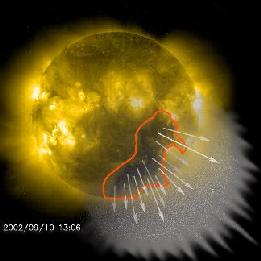A coronal hole streaming solar wind (September 12, 2002)

|
Coronal holes appear as dark areas of the corona when viewed in
ultraviolet light. This large hole area seen here on 10 September
2002 had a direct impact on Earth. Coronal holes are often the source
of strong solar wind gusts that carry solar particles into space.
This one spewed a large stream of charged particles out to our
magnetosphere and beyond. Solar wind streams take 2-3 days to travel
from the Sun to Earth, so it probably originated from the Sun about 9
September. The CELIAS/MTOF chart (link above) shows the erratic but definite increase in
velocity and density of the solar wind on 11 September.
Spaceweather.com reported that a moderate geomagnetic storm from the
solar wind stream triggered aurora 11 September that were visible
from the higher latitudes on Earth. The magnetic field lines in a coronal hole extend out into the solar wind rather than coming back down to the Sun's surface as they do in other parts of the Sun. Although they are usually located near the poles of the Sun, coronal holes can occur other places as well. SOHO began its Weekly Pick some time after sending a weekly image or video clip to the American Museum of Natural History (Rose Center) in New York City. There, the SOHO Weekly Pick is displayed with some annotations on a large plasma display. If your institution would also like to receive the same Weekly Pick from us for display (usually in Photoshop or QuickTime format), please send your inquiry to steele.hill@gsfc.nasa.gov. |


